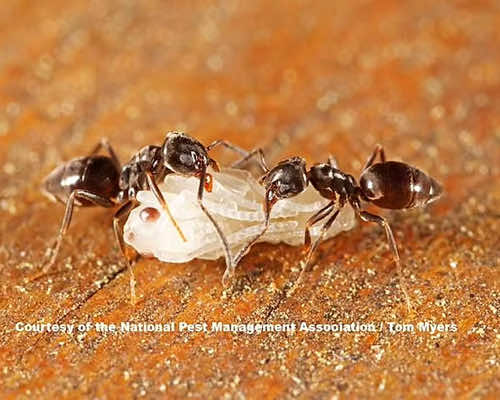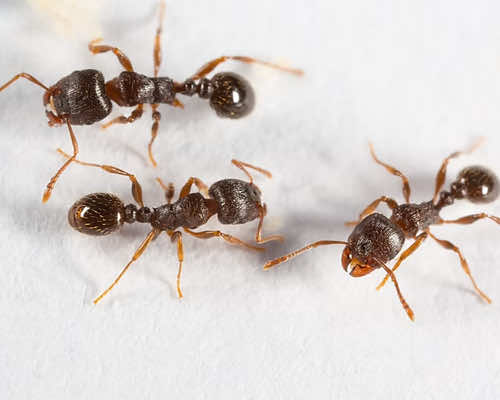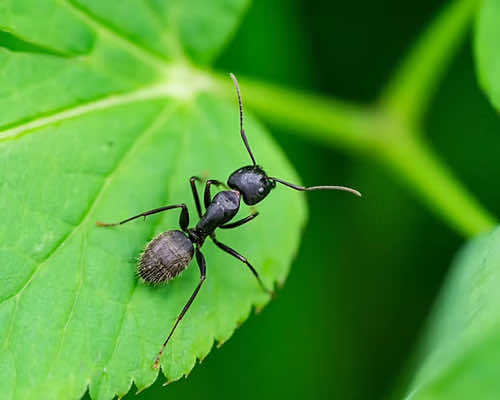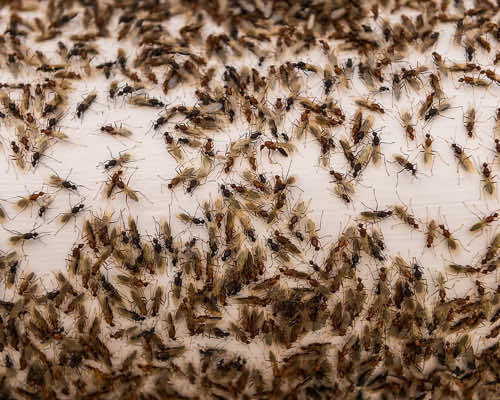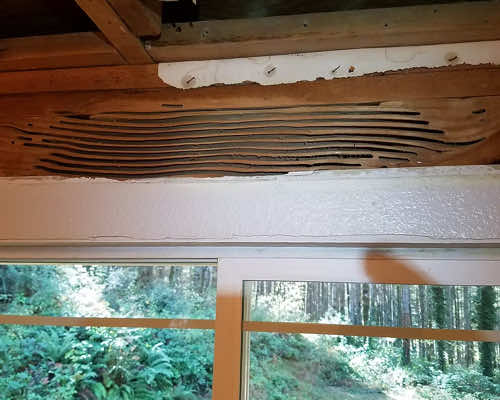Paramount Ant Control Service
There are over a thousand different species of ants in the world, but the most common culprits found on Long Island are odorous house ants, pavement ants, and black carpenter ants. The technicians at Paramount Pest Management specialize in Ant Control Service and are experts in the biology and habits of ants that invade homes and businesses on Long Island. We use the latest innovations and technology in pest management to safely and effectively eliminate ants through our professional Ant Control Service.

It all begins with a thorough inspection by one of our highly trained technicians to locate and identify ant trails, inside and out. Trails and active entry points are treated using materials that kill ants on contact, while also providing long-term residual control. In many instances, we will discreetly apply an odorless gel bait that is designed to kill ants slowly, giving the material time to reach and kill the Queen. We will also work with you to identify and correct conditions that attract ants and allow them access into your home or business.
Ants are covered in our comprehensive and affordable annual Home Pest Protection Plan (HPP), which provides year-round pest protection. We also offer 30-day plans to eliminate and control ants. All Paramount Ant Management Plans are backed by a re-treatment warranty protecting your home or business against re-infestation.
Need Help with Pests?
Protect Your Home - Get A Quote Now!
Odorous House Ants(Tapinoma sessile)
The odorous house ant is native to most of the United States and ranges from Canada through Mexico. The odorous house ant gets its name from the strong, rotten coconut-like smell it gives off when crushed.
Odorous House Ants Quick Facts
Color: Brown and/or Black
Shape: Segmented and oval
Size: Very small, 1/16 inch to 1/8 inch long
Found: Throughout the U.S., common across Long Island
Odorous House Ants Habitats & Habitat
Odorous ants create colonies with many queens and many homes. These homes are often temporary and will be found under pieces of wood or debris in landscaping. Since the odorous house ant produces multiple queens, and creates temporary nesting sites, they are difficult to control and best left to professionals for treatment.
Inside homes and other structures, these odorous house ants feed on many different items, but they prefer to feed on foods high in sugars. Indoors, odorous house ants nest near moisture sources, such as in wall voids near hot water pipes, in radiators and baseboard heating, beneath leaky fixtures, and inside wood damaged by termites.
Outside, the odorous house ant primarily eats honeydew excreted by aphids and on nectar from flowers and buds. They are known to move their outside nests every three months or so in response to rain.
Odorous Ant Threats
Odorous house ants do not cause structural damage, are not a public health threat, and are not known to bite or sting. However, they are often a concern to homeowners because they are often found inside homes in large numbers, and they can contaminate food.
If you notice odorous ants in your home or business, give us a call at 516-362-2005.
Odorous Ant Prevention
- Indoors, clean up spills and crumbs on counter tops and kitchen floors ASAP!
- Eliminate standing water everywhere you see it, in and around your home.
- Trim tree branches and bushes that come in close contact to the home to eliminate bridges for ants to get inside.
- Use caulk to seal open grout lines, cracks and crevices in the home, especially in kitchens and bathrooms.
- Use caulk to seal openings around exterior doors, windows, plumbing and electrical lines that enter the home.
- Keep firewood and other building materials stored as far from the home as possible to eliminate nesting sites.
Pavement Ants(Tetrasodium immigrans)
Pavement ants get their name because they make nests in or under cracks in pavement. These dark brown to black ants also infest homes and other structures on Long Island.
Pavement Ant Quick Facts
Color: Dark brown and/or Black
Shape: Segmented and oval
Size: Small, about a 1/8 inch long
Found: Throughout the U.S., common across Long Island
Pavement Ant Habitats & Habitat
These little black ants will eat almost anything, including other insects, seeds, honeydew, bread, meats, nuts and cheeses. They can forage in trails up to 30 feet from their colonies and are known to climb foundation walls to enter homes and other structures.
Once inside, pavement ants are most likely to be found on ground-level foundation walls, inside finished walls, within insulation and under flooring. Outside, these small black ants typically nest under stones, below cracks in concrete walkways, driveways, and gaps between paver patio blocks.
Pavement Ant Threats
Pavement house ants do not pose a public health risk, but they can contaminate food and should not be in your home.
If you notice pavement ants in your home or business, give us a call at 516-362-2005.
Pavement Ant Prevention
- Eliminate standing water everywhere you see it, in and around your home.
- Use caulk to seal openings around exterior doors, windows, plumbing and electrical lines that enter the home.
- Fill/seal gaps between paver stones and exterior tile/stonework
- Fill/seal cracks in driveway/blacktop
Carpenter Ants(Camponotus pennsylvanicus)
Among the largest ants you will see on Long Island, carpenter ants got their name because of the smooth tunnels they excavate inside wood to nest and raise their young.
Carpenter Ant Quick Facts
Color: Brown and/or Black
Shape: Segmented and oval
Size: Large, about 1/2 inch to 1 inch long
Found: Throughout the U.S., common across Long Island
Carpenter Ant Habits & Habitat
Carpenter Ants typically nest outdoors in rotting trees, tree stumps, rotting fence posts, and old firewood. Carpenter ants are of additional concern than other species of ants because carpenter ants can cause physical damage to homes. They excavate smooth tunnels inside wood holding homes together and can cause costly damage over time if not properly managed.
Carpenter ants typically enter homes through cracks and gaps around exterior doors, windows, or through plumbing and electrical penetrations into the home. They can also use overhead wires, shrubs, or tree limbs outdoors that touch the home as bridges to gain access inside.
Outdoors, carpenter ants feed primarily on honeydew, plant and fruit juices, insects and other arthropods. Inside homes, they will feed on sweets, eggs, meats, cakes and grease.
Although some carpenter ant workers are active during the day, most activity occurs in the evening, from shortly before dusk until dawn. Outside, colonies of carpenter ants hibernate during the winter and are inactive.
However, they will remain active in the colder months if a nest is in a well-heated portion of a home or building
Carpenter Ant Life Cycle
Development from carpenter ant egg to worker requires a minimum of about sixty days. The workers of the first generation are smaller than later generations because they can only be nourished from food reserves that are stored in the sole queen’s body. Once these workers become adults, the queen’s only function for the rest of her life is to lay eggs.
The adult workers forage for food, enlarge the nest, and feed/care for the queen and her new offspring. The workers eat dead insects and other small invertebrates, as well as the honeydew secreted by aphids and scale insects. They regurgitate this food into a liquid form to feed the larvae and the queen. Workers of future generations are larger because they eat a lot more than the sole queen could provide in the beginning.
The workers eat dead insects and other small invertebrates, as well as the honeydew secreted by aphids and scale insects. They regurgitate this food into a liquid form to feed the larvae and the queen. Workers of future generations are larger because they eat a lot more than the sole queen could provide in the beginning.
How Does Paramount Eliminate & Control Carpenter Ants?
Eliminating carpenter ants can be difficult because of their hidden nature and the presence of multiple satellite nests. Thus, treatment is best left to a licensed and experienced pest management professional. Paramount has the training, experience, equipment, and access to wider array of products than the public to effectively control carpenter ants.
It all begins with a through inspection by one of our highly trained technicians to locate parent and satellite nests, inside and out. Once located, active nests are treated using materials that will kill ants on contact while also providing long-term residual control. In some instances, we will inject small amounts of residual dust insecticide into infested wall voids through outlet and light switch openings. For heavy infestations, we may drill tiny holes in walls to inject insecticide dust into the voids.
We use the latest pest management innovations and technology to safely and effectively eliminate carpenter ants. We will also work with you to identify and correct the conditions that are attracting carpenter ants and allowing them access to your home.
All of our Ant Management Plans are backed by a re-treatment warranty protecting your home or business against re-infestation.


